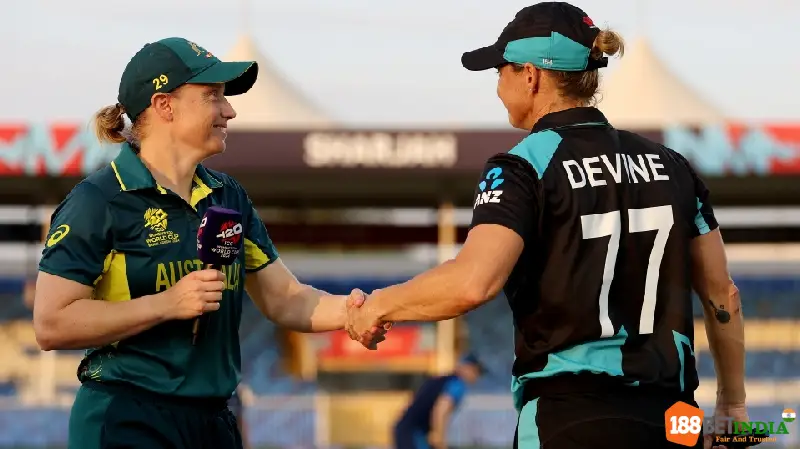The Women’s T20 World Cup is in full swing, and Tuesday brought a major shift in the balance of the competition. Australia Women vs New Zealand Women ended in a comprehensive victory for the Australians, who beat New Zealand by 60 runs in Sharjah. This result has significantly altered the semi-final qualification scenario, especially for India, who have now received a lifeline after a shaky start to their campaign.

Australia’s Dominant Win Over New Zealand
In what turned out to be a crucial fixture for both sides, Australia posted a competitive total of 148/8 in their 20 overs, with Beth Mooney leading the charge with 40 off 32 balls. New Zealand’s bowlers, led by Amelia Kerr (4 wickets), did their best to restrict Australia, but they were unable to prevent a challenging total from being set.
Chasing 149, New Zealand’s innings fell apart quickly. They were bundled out for 88 runs in 19.2 overs, courtesy of a devastating bowling performance from Megan Schutt (3 wickets for 3 runs in 3.2 overs) and Annabel Sutherland (3 wickets). New Zealand’s inability to build partnerships or maintain a steady run rate resulted in a heavy defeat, which saw their net run rate (NRR) take a major hit. The loss has brought significant implications for the semi-final race, especially for India.
Net Run Rate Shifts and India’s Semi-Final Chances
India, who started their campaign with a loss, now find themselves in a stronger position to qualify for the semi-finals, thanks to New Zealand’s defeat. Before the game, New Zealand held a net run rate (NRR) advantage over India. However, their hefty loss to Australia has changed the landscape. New Zealand’s NRR dropped to -0.050, while India’s is still in negative territory at -1.217. Although India still needs to improve their NRR, the gap between the two teams has closed, leaving the door open for India to capitalize on upcoming matches.
What’s Next for India?
India’s upcoming fixtures are against Sri Lanka and Australia. Here’s how the qualification scenarios play out for Harmanpreet Kaur’s side:
- Win Against Sri Lanka, Lose to Australia:
If India manage to defeat Sri Lanka but lose to Australia, their qualification will hinge on New Zealand’s performance. India would then hope for New Zealand to win only one of their remaining two matches, forcing a situation where NRR becomes the deciding factor. If India finishes level on points with New Zealand, they will need to surpass New Zealand’s NRR to progress to the semi-finals. - Win Both Games:
The simplest route for India to qualify would be to win both of their remaining matches. If they manage to beat both Sri Lanka and Australia, India would automatically secure a semi-final spot regardless of what happens in other games. In this scenario, New Zealand’s NRR and points wouldn’t matter. - New Zealand’s Matches:
New Zealand still have two matches left to play. If they lose both games, India would have a straightforward path to the semi-finals. But if New Zealand wins both, India must focus on improving their NRR to have any chance of progressing.
Pakistan in the Mix
While India and New Zealand battle it out for semi-final qualification, Pakistan is also firmly in the running. Currently, Pakistan holds a better NRR than both India and New Zealand, standing at +0.555. Pakistan, who are also on two points, have upcoming fixtures against New Zealand and Australia, making their road to qualification tough but not impossible.
Pakistan’s fate, like India’s, could very well be decided by net run rate, especially if all three teams end up tied on points. The importance of maintaining a healthy NRR cannot be overstated as the competition nears its conclusion.
Semi-Final Scenario Explained
- Australia is all but guaranteed a spot in the semi-finals after their victories over New Zealand and other opponents.
- India has a decent shot at making the semis, but it will largely depend on their own performances in the next two games as well as New Zealand’s results.
- New Zealand is still in the running, but their semi-final hopes are hanging by a thread after the heavy defeat to Australia. Their NRR took a hit, and now they must rely on winning both of their remaining games while keeping an eye on India’s performances.
- Pakistan has kept themselves in contention with a strong NRR and will look to upset both New Zealand and Australia in their final fixtures.
FAQs
Australia’s dominant 60-run win over New Zealand has significantly improved India’s chances of qualifying for the semi-finals. New Zealand’s net run rate took a major hit, closing the gap between them and India.
India must win at least one of their two remaining matches to stay in contention. If New Zealand loses one of their two games and India wins against Sri Lanka, India could qualify based on net run rate. Winning both matches would guarantee India’s semi-final spot.
Megan Schutt and Annabel Sutherland took three wickets each to bowl New Zealand out for 88 runs. Beth Mooney top-scored for Australia with 40 off 32 balls.
Net run rate (NRR) is critical in determining the final standings if teams are tied on points. It will likely play a decisive role in the semi-final qualification of teams like India, New Zealand, and Pakistan.
Pakistan is in a strong position with a better net run rate than both India and New Zealand. However, they have tough upcoming matches against New Zealand and Australia, which will determine their fate in the tournament.

Conclusion
India’s Women’s T20 World Cup journey has been full of twists, and thanks to Australia’s crushing win over New Zealand, India’s hopes of reaching the semi-finals are very much alive. The net run rate equation will play a massive role in determining the fate of these teams. However, India must focus on getting the best results in their remaining games while hoping that New Zealand falters once again.
The next few matches in this World Cup promise to be high-stakes encounters, with no room for error. Can India ride this wave of momentum and secure a semi-final berth? Only time will tell, but one thing is clear—every ball and every run will matter from here on out.
